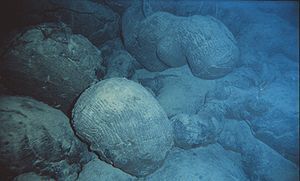Under Water 发表评论(0) 编辑词条
解释编辑本段回目录
Under Water 这个词在2008 2009 金融危机中成为一个常见的单词。
指的是房屋的价格比贷款余额还要低。美国政府对此类房屋业主进行了资助,比如设立基金刺激银行共同解决此类问题。
Underwater is a term describing the realm below the surface of water where the water exists in a natural feature (called a body of water) such as an ocean, sea, lake, pond, or river. Three quarters of the planet Earth is covered by water. A majority of the planet's solid surface is abyssal plain, at depths between 4000 and 5500 m (13,000 to 18,000 ft) below the surface of the oceans. The solid surface location on the planet closest to the center of the orb is the Challenger Deep, located in the Mariana Trench at a depth of 10,924 m (35,838 ft) under the sea.
 Under Water Under Water Note the bluish cast given to objects in this underwater photo of pillow lava. (NOAA)
Under Water Under Water Note the bluish cast given to objects in this underwater photo of pillow lava. (NOAA)
历史编辑本段回目录
History
Although a number of human activities are conducted underwater—such as research, scuba diving for work or recreation, or even underwater warfare with submarines—this very extensive environment on planet Earth is hostile to humans in many ways and therefore little explored.
An immediate obstacle to human activity under water is the fact that human lungs cannot naturally function in this environment. Unlike the gills of fish, human lungs are adapted to the exchange of gases at atmospheric pressure, not liquids. Aside from simply having insufficient musculature to rapidly move water in and out of the lungs, a more significant problem for all air breathing animals, such as mammals and birds, is that water contains so little dissolved oxygen compared with atmospheric air. Air is around 21% O2; water typically is less than 0.001% dissolved oxygen.
The density of water also causes problems that increase dramatically with depth. The atmospheric pressure at the surface is 14.7 PSI or around 100 kPa. A comparable water pressure occurs at a depth of only 10 m (33 ft.) (9.8 m (32 ft) for sea water.) Thus, at about 10 m below the surface the water exerts twice the pressure (2 atmospheres or 200 kPa) on the body as air at surface level.
For solid objects like our bones and muscles, this added pressure is not much of a problem; but it is a problem for any air-filled spaces like the mouth, ears, paranasal sinuses and lungs. This is because the air in those spaces reduces in volume when under pressure and so does not provide those spaces with support from the higher outside pressure. Even at a depth of 8 feet (2.5 m) underwater, an inability to equalize air pressure in the middle ear with outside water pressure can cause pain, and the tympanic membrane can rupture at depths under 10 ft (3 m). The danger of pressure damage is greatest in shallow water because the rate of pressure change is greatest at the surface of the water. For example the pressure increase between the surface and 10 m (33 ft) is 100% (100 kPa to 200 kPa), but the pressure increase from 30 m (100 ft) to 40 m (130 ft) is only 25% (400 kPa to 500 kPa).
Any object immersed in water is provided with a buoyant force that counters the force of gravity, appearing to make the object less heavy. If the overall density of the object exceeds the density of water, the object sinks. If the overall density is less than the density of water, the object rises until it floats on the surface.
With increasing depth underwater, sunlight is absorbed, and the amount of visible light diminishes. Because absorption is greater for long wavelengths (red end of the visible spectrum) than for short wavelengths (blue end of the visible spectrum), the colour spectrum is rapidly altered with increasing depth. White objects at the surface appear bluish underwater, and red objects appear dark, even black. Although light penetration will be less if water is turbid, in the very clear water of the open ocean less than 25% of the surface light reaches a depth of 10 m (33 feet). At 100 m (330 ft) the light present from the sun is about 0.5% of that at the surface.
The euphotic depth is the depth at which light intensity falls to 1% of the value at the surface. This depth is dependent upon water clarity, being only a few meters underwater in a turbid estuary, but may reach 200 meters in the open ocean. At the euphotic depth, plants (such as phytoplankton) have no net energy gain from photosynthesis and thus cannot grow.
At depths greater than a few hundred meters, the sun has little effect on water temperature, because the sun's energy has been absorbed by water at the surface. In the great depths of the ocean the water temperature is very cold. In fact, 75% of the water in the world ocean (the great depths) has a temperature between 0 °C and 2 °C.
Water conducts heat around twenty five times more efficiently than air. Hypothermia, a potentially fatal condition, occurs when the human body's core temperature falls below 35 °C. Insulating the body's warmth from water is the main purpose of diving suits and exposure suits when used in water temperatures below 25 °C.
Sound is transmitted about 4.5 times faster in water (about 1435 m/s in fresh water) as it is in air (330 m/s). The human brain can determine the direction of sound in air by detecting small differences in the time it takes for sound waves in air to reach each of the two ears. For these reasons divers find it difficult to determine the direction of sound underwater.
附件列表
→如果您认为本词条还有待完善,请 编辑词条
词条内容仅供参考,如果您需要解决具体问题
(尤其在法律、医学等领域),建议您咨询相关领域专业人士。
0
标签: 金融危机

同义词: 暂无同义词
关于本词条的评论 (共0条)发表评论>>
 编辑实验
创建词条
编辑实验
创建词条
